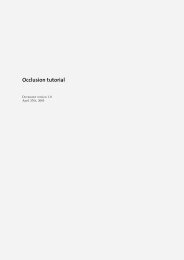mental ray Architectural and Design Visualization Shader Library
mental ray Architectural and Design Visualization Shader Library
mental ray Architectural and Design Visualization Shader Library
Create successful ePaper yourself
Turn your PDF publications into a flip-book with our unique Google optimized e-Paper software.
2.5 Detailed Description of Material Parameters 31Note how the helicopter does not feel “grounded” in the left image <strong>and</strong> the shadows underthe l<strong>and</strong>ing skids are far too vague. The right image uses AO to “punch out” the details <strong>and</strong>the contact shadows.One can also set ao do details to 2, which enables a more sophisticated AO mode introducedin <strong>mental</strong> <strong>ray</strong> 3.6. Instead of doing simple occlusion, which can only add “darkness” of varyingdegree, the shader will actually look at the color of the surrounding objects, <strong>and</strong> use that colorrather than “darkness”. Since this involves shading each of the points hit, this is not as fastas pure AO, but it has the additional effect of resolving both bright <strong>and</strong> dark details.ao do details = 1 ao do details = 2The image on the left illustrates the problem with the traditional AO; it applies to all indirectillumination <strong>and</strong> always makes it darker. It is most noticeable on the glowing sphere (whichhas a dark spot under it) but can also be perceived on the floor in front of the cube whichis suspiciously dark, even though the cube is strongly lit on the front, as well as between thelegs of the horse <strong>and</strong> the underside of the red sphere.In contrast, the image on the right is using ao do details=2 for all materials, <strong>and</strong> now thefloor is correctly lit by the glowing ball, there is a hint of white bounce-light on the floor fromthe cube, there is light between the legs of the horse, <strong>and</strong> on the underside of the red ball.If you find that using AO creates a “dirty” look with excessive darkening in corners, or darkrims around self-illuminated objects, try to set ao do details to 2 for a more accurate result.The ao dark parameter sets the “darkness” of the AO shadows. It is used as the multipliervalue for completely occluded surfaces. In practice this means: A black color will make theAO effect very dark, a middle g<strong>ray</strong> color will make the effect less noticeable (brighter) etc.When the new ao do details mode 2 is used, it instead sets the “blend” between the colorpicked up from nearby objects <strong>and</strong> ”darkness”. The blend is:(1 − ao dark) ∗ (objectcolors) + black ∗ ao dark.The ao ambient parameter is used for doing more “traditional” AO, i.e. supplying theimagined “ever present ambient light” that is then attenuated by the AO effect to createshadows.While “traditional AO” is generally used when rendering without other indirect light, it canalso be combined with existing indirect light. One needs to keep in mind that this magical“ever present ambient light” is inherently non-physical, but may perhaps help lighten sometroublesome dark corners.
















